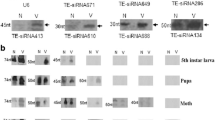Abstract
Glutathione S-transferases (GSTs) are a multifunctional super gene family, some of which play an important role in insecticide resistance. In this research, we used a real-time quantitative RT-PCR method, and a novel strategy, to measure the transcriptional level per gene copy using an exogenous RNA reference and DNA reference. The transcription levels of six BmGST genes in different tissues of fifth instar Bombyx mori larvae and their responses to insecticide and fluoride were investigated. The results show different levels and patterns of expression of the different BmGSTs in the various tissues observed. The BmGSTs can be induced by insecticide and fluoride, but their responses to each are different. The results of this research are helpful in studying the tissue-specific expression of BmGSTs in Bombyx mori, and in developing new pesticide resistant silkworm varieties.




Similar content being viewed by others
References
Kostaropoulos I, Papadopoulos AI, Metaxakis A, Boukouvala E, Papadopoulou-Mourkidou E (2001) Glutathione S-transferase in the defense against pyrethroids in insects. Insect Biochem Mol Biol 31:313–319
Dauteman WC, Kerkut GA, Gilbert LI (1985) Comprehensive insect physiology biochemistry and pharmacology. Pergamon Press, New York, pp 713–730
Sheehan D, Meade G, Foley VM, Dowd CA (2001) Structure, function and evolution of glutathione transferases: implications for classification of non-mammalian members of an ancient enzyme superfamily. J Biol Chem 360:1–16
Chelvanayagam G, Parker MW, Board PG (2001) Fly fishing for GSTs: a unified nomenclature for mammalian and insect glutathione transferases. Chem Biol Interact 133:256–260
Motoyama N, Dauterman WC (1980) Glutathione S-transferases: their role in the metabolism of organophosphorus insecticides. Rev Biochem Toxicol 2:49–69
Clark AG, Shamaan NA (1984) Evidence that DDT-dehydrochlorinase from the house fly is a glutathione S-transferase. Pest Biochem Physiol 22:249–261
Vontas JG, Small GJ, Hemingway J (2001) Glutathione S-transferases as antioxidant defence agents confer pyrethroid resistance in Nilaparvata lugens. J Biol Chem 357:65–72
Hayes JD, Flanagan JU, Jowsey IR (2005) Glutathione transferases. Annu Rev Pharmacol Toxicol 45:51–88
Yu SJ (1992) Detection and biochemical characterization of insecticide resistance in fall armyworm (Lepidoptera: Noctuidae). J Econ Entomol 85:675–682
Le Goff G, Hilliou F, Siegfried BD, Boundy S, Wajnberg E, Sofer L, Audant P, Ffrench-Constant RH, Feyereisen R (2006) Xenobiotic response in Drosophila melanogaster: sex dependence of P450 and GST gene induction. Insect Biochem Mol Biol 36:674–682
Yamamoto K, Zhang PB, Banno Y, Fujii H (2006) Identification of a sigma-class glutathione S-transferase from the silkworm, Bombyx mori. Appl Entomol 130:515–522
Yamamoto K, Zhang PB, Miake F, Kashige N, Aso Y, Banno Y, Fujii H (2005) Cloning, expression and characterization of theta-class glutathione S-transferase from the silkworm, Bombyx mori. Comp Biochem Physiol 141:340–346
Yu QY, Lu C, Li B, Fang SM, Zuo WD, Dai FY, Zhang Z, Xiang ZH (2008) Identification, genomic organization and expression pattern of glutathione S-transferases in the silkworm, Bombyx mori. Insect Biochem Mol Biol 38:1158–1164
Zou FM, Lou DS, Zhu YH, Wang SP, Jin BR, Gui ZZ (2010) Expression profiles of glutathione S-transferase genes in larval midgut of Bombyx mori exposed to insect hormones. Mol Biol Rep. doi: 10.1007/s11033-010-0150-y
Chen YY, Wu YC (1994) Study on the effect of fluoride on the growth, development and economic parameters of silkworm, Bombyx mori. Sericologia 34:627–635
Chen YY, Du X, Jin YX (2005) Cytochemical evidence for an anomalous dose-response of acid phosphatase activity in the blood but not the midgut of fluoride-treated silkworm larvae, Bombyx mori. Fluoride 38:133–138
Miao YG, Jiang LJ, Bharathi D (2004) Biochemical effects of fluoride on hemolymph of the silkworm, Bombyx mori. Fluoride 37:117–124
Li GL, Roy B, Li XH, Yue WF, Wu XF, Liu JM, Zhang CX, Miao YG (2009) Quantification of silkworm coactivator of MBF1 mRNA by SYBR Green I real-time RT-PCR reveals tissue- and stage-specific transcription levels. Mol Biol Rep 36(5):1217–1223
Wang ZL, Zha XF, He NJ, Xiang ZH, Xia QY (2010) Molecular cloning and expression analysis of Bmrbp1, the Bombyx mori homologue of the Drosophila gene rbp1. Mol Biol Rep 37(5):2525–2531
Xia HC, Wu C, Xu QG, Shi J, Feng F, Chen KP, Yao Q, Wang Y, Wang L (2010) Molecular cloning and characterization of lactate dehydrogenase gene 1 in the silkworm, Bombyx mori. Mol Biol Rep. doi: 10.1007/s11033-010-0302-0
Zhang Y, Wei ZG, Li YY, Chen YH, Shen WD, Lu CD (2009) Transcription level of messenger RNA per gene copy determined with dual-spike-in strategy. Anal Biochem 394:202–208
Stevens JL, Snyder MJ, Koener JF, Feyereisen R (2000) Inducible P450 s of the CYP9 family from larval Manduca sexta midgut. Insect Biochem Mol Biol 30:559–568
Livak KJ, Schmittgen TD (2001) Analysis of relative gene expression data using real-time quantitative PCR and the 2−ΔΔCT method. Methods 25:402–408
Acknowledgments
This work was supported by the foundation of post scientist in National Sericultural System (nycytx-27-gw307) and the project 31072086 supported by National Natural Science Foundation of China.
Author information
Authors and Affiliations
Corresponding author
Additional information
Guo-dong Zhao and Yi-ling Zhang contributed equally to this work.
Electronic supplementary material
Below is the link to the electronic supplementary material.
Rights and permissions
About this article
Cite this article
Zhao, Gd., Zhang, Yl., Gao, Rn. et al. Quantitative analysis of expression of six BmGST genes in silkworm, Bombyx mori . Mol Biol Rep 38, 4855–4861 (2011). https://doi.org/10.1007/s11033-010-0626-9
Received:
Accepted:
Published:
Issue Date:
DOI: https://doi.org/10.1007/s11033-010-0626-9




